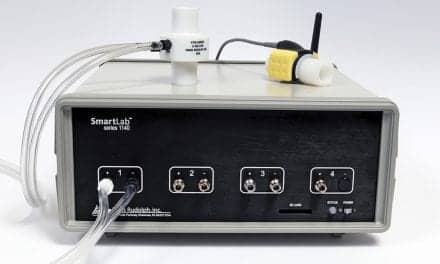Exercise tests can aid clinicians in diagnosing and assessing breathing disorders unexplained by resting tests.

Exercise evaluations are designed to provide additional information not available from resting tests. These are useful when patients present with a history of exertional limitations that cannot be explained by the resting diagnostic workup alone.
Practitioners have had many questions about which protocols to use in a given patient situation. Is there a cookbook to follow? Not quite, but we can look at the history of the patient and determine what areas need to be evaluated to put the proper components together:
• Disability evaluation
• Bronchospasm evaluation
• Lung volume reduction surgery (LVRS) evaluation
• Dyspnea/COPD quantification
• Pre/post pulmonary rehabilitation
• Risk stratification for thoracic or abdominal surgery
• Lung transplant evaluation
• Vocal cord evaluation
• Monitoring response to therapy
• Research
Testing can range from low tech and low expense to high-cost equipment and lengthy evaluations. At the low end of the scale are the various walk tests. Walk tests are functional field evaluations in the clinical setting that are modifications of the traditional graded exercise testing. Walk tests can be used to monitor progress in rehabilitation, to monitor changes pre- and post-intervention, and to assess research outcomes. We will discuss two categories of low level tests: timed tests and symptom-limited tests.
Timed Tests
6 and 12 minute walk tests (MWT)
The distance covered in the 6 or 12 minute walk tests should be measured in meters, with distance as a primary outcome. Aerobic capacity can be predicted from the 12-minute walk test using the following formula:1
VO2max (mL x kg-1x min-1) = 3.126 x (meters covered in 12 minutes) – 11.3.
For reference, a normal relaxed human walking speed is 67–80 m/min-1 (2.3–3.0 mph), and a normal 12 MWT distance is approximately 800 m for relaxed walking pace. Most references for the 12-minute walk test state that it is to be performed on a flat, straight, uncarpeted pathway, seldom traveled by others.2 Baseline and post-Borg scales should be performed to evaluate dyspnea (and leg fatigue optionally); heart rate and blood pressure should be monitored. [The Borg Rating of Perceived Exertion (RPE) is based on the physical sensations a person experiences during physical activity, including increased heart rate, increased respiration or breathing rate, increased sweating, and muscle fatigue. Although this is a subjective measure, a person’s exertion rating may provide a fairly good estimate of the actual heart rate during physical activity—ed.]
The 6 MWT is a derivation of the 12 MWT; and the ATS guidelines, published in 2002,3,4 for 6 MWT include the following: The test should be performed on a flat, straight, uncarpeted pathway, seldom traveled by others. It should be on a course 30 m in length, marked every 3 m, with turnaround points marked with cones, so the patient can walk around the cones unobstructed. Baseline parameters for Spo2 (optional), blood pressure, heart rate, and Borg scales for dyspnea and leg fatigue are to be recorded. The instructions are given using standard language, with lap counter and timer zeroed. The staff demonstrates one lap for the patient and should use standard phrases of encouragement every minute of the test and mark each lap with the counter. Posttest, the staff should again record Borg, heart rate, Spo2 (optional), and distance, and ask if anything kept the subject from walking further.
On both timed walk tests, pulse oximetry is optional, since distance is the primary outcome. It is recommended that patients carry or pull their supplemental oxygen if needed, and the flow rate needed should be noted on reports. The ATS guidelines do not recommend a practice walk, but if one is performed, a minimum of a 1-hour wait is suggested between walks.
The advantages of the timed walk tests are that they are similar to the familiar daily activity of walking, require little conscious effort to change speed if the patient becomes fatigued, are inexpensive to perform, and require little equipment. A disadvantage is that it might be difficult for patients that need to carry or roll supplemental oxygen.
The 6 MWT is the most commonly chosen of walk options. It is easier to administer and better tolerated, and reflects activities of daily living. Published data report clinical significance with a change in the distance walk of 54 meters minimum.3
If space is an issue in a laboratory, the treadmill 6-minute walk is an option, although the initial equipment start-up is more expensive. As well, the apparatus is not as familiar to patients (especially elderly subjects) as is free walking in the hallway. It does not simulate the activities of daily living as well as the hall-walk test and values are not interchangeable. The results of the treadmill test tend to be lower than those of the traditional hall-walk test but are reproducible from test to test. Because the patient is stabilized on the exercise apparatus, monitoring of vital signs such as Spo2 and blood pressure, and electrocardiography (ECG), are easy to measure.
Symptom-Limited Tests
10 m incremental shuttle walk test (ISWT)
The ISWT5,6,8 was initially developed for athletes and then modified to assess patients with COPD.5,6 The test is performed on a 10-m course in a flat, unobstructed corridor with cones at either end, set 0.5 m from the end.7 Patients walk at a gradually increasing speed until they reach their symptom-limited maximum. A tone sounds to help patients maintain and/or increase their pace. Speed is increased by small amounts at each 1-minute interval. The test is terminated if the patient becomes too breathless to continue or if they cannot complete the 10-m length in the time allowed. There is a strong correlation between the ISWT and peak Vo2 performed on a standard cardiopulmonary graded exercise test.8
The 10-m ISWT begins and ends with Borg evaluations and heart-rate documentation. The test is explained, and the patient walks up and down the 10-m course. The test begins with the sound of a triple beep. At regular intervals thereafter, single audible beeps indicate when the subject should round the cones at the end of the course. Each minute a triple beep signals the patient to increase speed by 0.17 m/s. Of special note, with this test type, the technician reminds patients to increase speed when the triple beep sounds, but no encouragement is given.5-7 The test is highly reproducible when repeated, it is inexpensive, and it requires no major equipment. Singh et al6 found the test produced a higher heart rate and a symptom-limited maximal performance not seen in 6 MWT. One downside to this test is that it is subject to variation in patient motivation.
The endurance 10 m shuttle walk test (ESWT)
This test is valuable because it can be used to assess the endurance capacity of COPD patients and estimate Vo2max. It is a constant-paced walking test controlled externally by audio tone tapes. An initial ISWT is performed to obtain a predicted Vo2 to determine ESWT speed for subsequent testing. The same 10-m course that is used in the ISWT is used for the ESWT (in a flat, unobstructed corridor; cones at either end). Patients are instructed to walk until too tired or breathless to continue—with a 20-minute limit.
An ISWT is performed as per previous instructions, followed by 40 minutes of rest. The speed for ESWT is calculated, and the proper audio tape is obtained.
At baseline, Borg scales are recorded and constant telemetry heart rate monitoring is usually performed. The patient then performs a 100-second warm-up at a slower pace to practice the course. The triple tone sounds with a recorded message, the tone frequency increases to the predetermined ESWT rate, and then tone frequency is constant for 20 minutes maximum. Posttest, Borg scales, reason for stopping, and endurance time are all recorded.
Symptom-limited stair climb
The stair climb test9 can be used to estimate Vo2 uptake and reserve in COPD patients. Subjects are instructed: “Climb as far as possible at your own pace, using the railing for balance only.” They are told to stop once they can climb no further, and the number of stairs is counted. This is a simple test with no major equipment costs. The original study had spirometry and baseline arterial blood gases performed prior to the test. This test is useful as a tool to predict postoperative risk stratification for complications. There would be a potential disadvantage if the patient had any problems while in the stairwell away from assistance and unable to easily call for help. This potential safety risk might necessitate the need for two staff members in attendance during testing.
Bronchospasm Evaluations and COPD
Free run
The free run can be a simple test performed to evaluate a patient in the home or athletic team situation for bronchospasm by monitoring peak flow or spirometry pretest and at 5-minute timed intervals after an outdoor free run. This test is not routinely performed in an unmonitored medical setting due to potential liabilities.
Bronchospasm evaluation
Baseline spirometry is performed prior to a peak exercise performance on either a treadmill or bicycle ergometer. Spirometry is monitored at 5-minute intervals for 30 minutes after exercise completion to check for bronchospasm. This test is easily performed on all age groups as long as care is taken to consider the patient’s limitations, if any, with the apparatus. The test can be streamlined with minimal monitoring or can be deluxe with add-ons such as automated blood pressure, pulse oximetry, ECG, cardiopulmonary gas exchange, and exercise flow volume loops.
Lung volume reduction surgery evaluation
Part of the evaluation for a patient contemplating lung volume reduction surgery is a graded exercise test. The patient is pretreated with a bronchodilator and prepped for exercise with baseline ECG, pulse oximetry, blood pressure, and Borg scales for dyspnea and leg fatigue. The patient begins by resting in a chair and breathing 30% inspired oxygen via face mask for 10 minutes. The patient is then moved to an electromagnetically braked cycle ergometer and rests sitting on the bicycle and breathing 30% supplemental oxygen through the exercise circuit for 5 minutes. The patient then performs an unloaded warm-up at a ramp rate of 5 or 10 watts for 3 minutes prior to beginning exercise. The ramp rate is determined by the previously performed maximum voluntary ventilation (MVV). The ramp rate is set at 5 watts for MVV of 40 L/min and is set at 10 watts for MVV of >40 L/min. Pulse oximetry and ECG are continuously monitored, and blood pressure is measured intermittently. The patient continues to maximum exertion. Borg scales are recorded at peak exercise with the patient’s reason for test termination. Following the test, the patient actively cools down for 3 minutes if possible. The American Thoracic Society document reviews outcomes of a multisite 5-year trial using this protocol as part of its study.10
Dyspnea evaluation
A patient being evaluated for unexplained dyspnea might need a complete cardiopulmonary exercise test with full vital signs monitoring. Blood gases should be sampled pre and peak exercise, or, alternatively, an arterial line for multiple arterial samples can be placed. Spirometry and Borg scales for dyspnea and leg fatigue should be checked pre and peak exercise. Spirometry is continued at 5-minute intervals after the conclusion of exercise for 30 minutes. The reason for test termination should be noted. Ideally, exercise flow volume loops or inspiratory capacity maneuvers should be performed. This test helps pick up subtle changes in exercise-induced air trapping not otherwise diagnosed either during routine exercise testing or during the patient’s resting state. This test option is one of the costliest options presented, especially if the arterial line with multiple blood gases and lactate levels are added; but it might finally explain the patient’s symptoms when other tests have failed to do so.
Vocal cord evaluation
Laryngoscopy is performed within a few seconds of the peak of a maximal exercise test, which is usually performed on a treadmill. The main objective is to evaluate the vocal cords, so, to ensure safety, minimal monitoring is performed. The patient needs to be quickly moved off the exercise apparatus and placed in a chair, positioned for the physician to perform the laryngoscopy. Monitoring should continue and the patient cautioned ahead of time that they may feel dizzy, since no active cooldown will be performed. Typically, spirometry is not performed as part of this evaluation. The subject may have been referred for this test because of abnormal spirometry in a past visit.
Steady state exercise
The steady state exercise test is a submaximal test typically performed to evaluate sensitive changes that have occurred in response to treatment from interventions such as medication, therapy, or surgery. It is a useful tool for research studies and is especially important in quantifying changes in pulmonary patients. Ventilatory limitation may prevent pulmonary patients from reaching a maximal exercise work load. Thus, standard exercise testing may not show the dramatic improvements the patient truly has made in response to the interventions. The subjects must undergo an initial maximal exercise test, then, at a later time, the sub-maximal test is performed at a percentage of the initial peak Vo2 (ie, 50%–75%). The downside is that initially this is a two-step process, as the therapist must obtain the baseline maximal exercise test prior to the patient’s performing the submaximal exercise test. This second test can be performed at a later date or after waiting several hours on the same day. This is a very valuable test for measuring changes in the pulmonary population.
No test is perfect for every situation. Patients and their symptoms vary widely, and therapists must adapt evaluation tools to meet the diagnostic goals set by the ordering physicians. The Table (click here for PDF of table) included with the online version of this article (www.respiratory-therapy.com), will assist in evaluating the options for the various tests. So jump on board; whether it is cycle, walk, or run—pick a variation.
Catherine Foss, RRT, RPFT, is a respiratory therapist, respiratory care services, Duke University Medical Center, Durham, NC.
References
1. Dwyer GB, Davis SE, eds. ACSM’s Health–Related Physical Fitness Assessment Manual. Philadelphia: Lippincott Williams & Wilkins; 2005.
2. Berstein ML, Despars JA, Singh NP, Avalos K, Stansbury DW, Light RW. Reanalysis of the 12-minute walk in patients with chronic obstructive pulmonary disease. Chest. 1994;105(1):163-7.
3. Solway S, Brooks D, Lacasse Y, Thomas S. A qualitative overview of the measurement properties of functional walk tests used in the cardiorespiratory domain. Chest. 2001;119(1):256-70.
4. ATS Committee on Proficiency Standards for Clinical Pulmonary Function. ATS statement: guidelines for the six-minute walk test. Am J Respir Crit Care Med. 2002;166(1):111-7.
5. Lewis ME, Newall C, Townend J, Hill SL, Bonser RS. Incremental shuttle walk test in the assessment of patients for heart transplantation. Heart. 2001;86(2):183-7.
6. Singh SJ, Morgan MD, Hardeman AE. Development of a shuttle walking test of disability in patients with chronic airways obstruction. Thorax. 1992;47(12):1019-24.
7. Morales F, Martinez A, Mendez M, et al. A shuttle walk test for assessment of functional capacity in chronic heart failure. Am Heart J. 1999;138(2 Pt 1): 291-8.
8. Singh SJ, Morgan MD, Hardeman AE. Comparison of oxygen uptake during a conventional treadmill test and the shuttle walking test in chronic airflow limitation. Eur Respir J. 1994;7(11):2016-20.
9. Girish M, Trayner E, Dammann O, Pinto-Plata V, Celli B. Symptom-limited stair climbing as a predictor of postoperative cardiopulmonary complications after high-risk surgery. Chest. 2001;120:(4):1147-511.
10. Management of stable COPD: surgery in and for COPD. Available at: www.thoracic.org/COPD/10/surgery_for_copd.asp. Accessed May 25, 2005.









